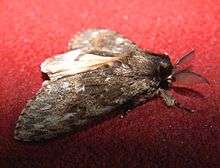Lymantria serva
| Ficus tussock moth | |
|---|---|
 | |
| Scientific classification | |
| Kingdom: | Animalia |
| Phylum: | Arthropoda |
| Class: | Insecta |
| Order: | Lepidoptera |
| Family: | Lymantriidae |
| Genus: | Lymantria |
| Species: | L. serva |
| Binomial name | |
| Lymantria serva (Fabricius, 1793)[1] | |
| Synonyms | |
| |
Lymantria serva, the ficus tussock moth, also called serva tussock moth, xian-yue-du-er (crescent-moon tussock moth) or hung-do-er (rainbow tussock moth) (in Chinese) is a moth in the Lymantriidae family. It is found in Nepal, Sri Lanka, India (Assam) and China (Yunnan). It is possibly also found in Taiwan and Hongkong, but these records might in fact be Lymantria iris.[2]
Description
The length of the forewings is 17–19 mm for males and 26–36 mm for females. In male, body color brownish. The abdomen slightly tinged with crimson color. Forewing irrorated with dark scales. There are indistinct double lunulate antemedial, medial, and postmedial lines present. The black lunule at end of cell, but no spot in the cell. Hindwings are pale brownish fuscous in color. In female, abdomen crimson, with a dark line on vertex and series of lateral black spots, the extremity is brownish. Hindwings with crimson suffused inner area.[3]
Ecology
The larvae feed on Ficus species and Shorea robusta. The larvae have an exceptionally long development period with 10 to 12 instars. The sex pheromone 2-Methyl-(Z)-7-octadecene is known to emit by L. serva and allopatric with Lymantria lucescens.[4]
References
- ↑ Site Markku Savela
- ↑ Pogue, Michael G. & Paul W. Schaefer (2007) A review of selected species of Lymantria Hübner [1819] (Lepidoptera:Noctuidae:Lymantriinae) from subtropical and temperate regions of Asia, including the description of three new species, some potentially invasive to North America. Washington D.C.: Forest Health Technology Enterprise Team
- ↑ Hampson G. F. (1892). "The Fauna Of British India Including Ceylon And Burma Moths Vol-i". Digital Library of India. p. 558. Retrieved 4 July 2016.
- ↑ Gries G, Schaefer PW, Gries R, Fan YB, Higashiura Y, Tanaka B. "2-Methyl-(Z)-7-octadecene: sex pheromone of allopatric Lymantria lucescens and L. serva.". NCBI. Retrieved 21 July 2016.